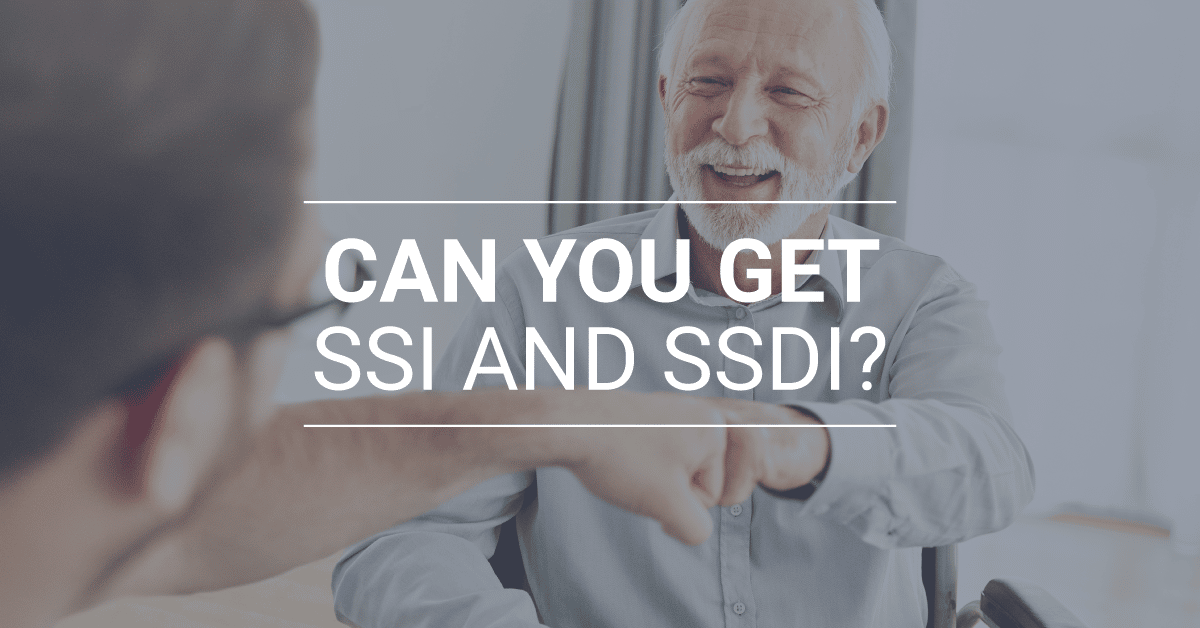
If you have a medical condition that prevents you from working, you will probably apply for one of two federal programs: Social Security Disability Insurance (SSDI) or Supplemental Security Income (SSI). Their respective eligibility requirements are different, but they share an important purpose: helping disabled individuals access the financial resources and medical care they need.
The general assumption is that if you are approved for one, you can’t receive the other. However, there are situations where you can qualify for both SSI and SSDI benefits. In this blog, we’ll go over the SSI vs. SSDI differences, answer the question “Can you get SSI and SSDI at the same time?” and explain how a disability attorneys at Bross & Frankel, PA, can help.
Can You Get SSI and SSDI? Concurrent Benefits
SSI and SSDI are aimed at two different types of claimant. The former provides financial benefits to people who cannot work, have few assets and have a limited income while the latter is aimed at solely disabled workers and is not means-tested. Despite these dissimilarities, in some cases, you may be eligible for concurrent benefits, meaning that you can collect both SSI and SSDI at the same time.
This could happen if you:
- Became disabled early in your career
- Worked a minimum-wage job
- Did not work full-time during the 10 years before you became disabled
Bross & Frankel, PA can help you understand the eligibility criteria and other rules associated with these programs and explain your options for maximizing your income. We will also assist you in fighting for the benefits you qualify for, even if your initial application has been denied.
Should You Apply for Both SSI and SSDI benefits?
If you are applying for SSI, your countable income each month cannot exceed the cap of $1,767 per month for an individual or $2,607 for a couple. (There is also a resource limit of $2,000 for individuals and $3,000 for married couples.) Considering these limitations, what is the value of applying for SSI and SSDI concurrently?
There are actually several circumstances where you may want to consider drawing both. For one thing, if your SSDI benefits are minimal because you worked minimum-wage jobs all your life, collecting SSI at the same time can increase your monthly income, either permanently or until you’re able to start working again.
In addition:
- You can receive back pay for both SSI and SSDI- that is, the disability payments the SSA owes you for the months before your concurrent disability claim is approved. Considering that the SSA can take a while to finally approve benefits, you may be looking at a significant payout.
- SSDI has a mandatory waiting period, with benefits starting six months after the date of your disability onset. With SSI, there is no similar delay, so you could collect financial benefits while waiting for your monthly payments from SSDI to start.
- Concurrent claims also provide faster access to necessary health care. Most SSDI recipients are eligible for Medicare once they have been receiving benefits for 24 months. In most states, SSI recipients are automatically eligible for Medicaid, which may cover your health costs until Medicare begins. In addition, you may be able to stay on Medicaid, which covers some costs that Medicare does not.
Both disability programs have their own strict and unique requirements that our SSD attorneys thoroughly understand. Our team can help you determine whether you qualify for SSDI and SSI benefits and, if so, whether a concurrent claim is an appropriate option for your circumstances.
How to Apply for Both SSI and SSDI
When you apply, the SSA will determine if you qualify for SSDI, SSI, or concurrent disability benefits. The decision will be guided by your present income and assets, as well as those of your spouse. No matter how you define your claim, it will be evaluated the same way. This means that:
- The SSA will use its Blue Book to see if your medical condition matches a listed impairment and, if so, whether you meet the medical definition of disability under that listing. Requirements vary based on type of disability. For example, if you are applying due to spinal stenosis, you must show signs of neurological compromise and muscle weakness.
- With SSDI, you will need sufficient work credits, which you earn by working and paying into Social Security’s system. Your age determines how many work credits you need. In order to qualify for benefits, a worker typically needs to have worked five of the last ten years.
- For SSI, work credits are not an issue because the program is based on financial need. If you meet the criteria for income and assets, you stand a good chance of being approved for disability benefits.
What if Your Disability Benefits Application is Denied?
While denials are disheartening, especially when you know you’ve met the necessary disability requirements, it is important to remember that the majority of claimants are denied after their initial application. There are a number of reasons why this happens with both SSDI and SSI, including:
- A technical issue with your application, such as leaving an important section blank.
- Your name, date of birth, and Social Security Number didn’t match.
- You did not have sufficient work credits for your age (with SSDI).
- You did not meet the asset or current income limits for SSI.
- The Disability Examiner who reviewed the application did not believe you have a qualifying disability.
If this happens to you, you can submit a request for reconsideration. During this first stage of the appeal process, an examiner who was not involved in your first determination will review your application, along with any new evidence provided. Should the result be another denial, you may ask for a hearing, which is a review of your disability claim by an administrative law judge, or ALJ.
If you disagree with the ALJ’s disability decision, the next step is to request a review by the SSA Appeals Council. The Appeals Council may deny or dismiss your request for review if it finds the hearing decision adheres to Social Security law and regulations. It may also decide to issue a new decision or remand the matter back to an ALJ for further consideration. Should you disagree with the outcome, the last stage of the appeals process is to file a civil action in a federal district court.
FAQS
How Can Bross & Frankel, PA, Help With My SSI or SSDI Claim?
Every case is unique, and we treat it as such. Using their years of experience in disability law, the attorneys at Bross & Frankel, PA, can help you determine whether you qualify for concurrent benefits and guide you through the often-complicated process of collecting evidence, completing the application, and submitting everything to the SSA.
Should the SSA deny your claim, we can assist you in fighting the denial. We can:
- Request an appeals hearing on your behalf
- Examine and understand why your claim was denied
- Build a strong case for why you deserve benefits from both programs
- Represent you before the Administrative Law Judge and during other public hearings
Once the SSA approves your benefits, you will usually start receiving them within weeks. Moreover, you might be entitled to back benefits covering the period between when you applied and when your case was decided.
In addition, you won’t need to worry about the cost of legal representation, as we handle all disability cases on a contingency basis. There is no fee for our services if we are not successful in obtaining benefits or compensation for you. We only charge you if we win.
SSDI or SSI- Which Pays More?
In most cases, you will receive more money from SSDI than SSI. In 2024, the average SSDI monthly payment for an individual is approximately $1,450 while SSI has a maximum federal benefit rate of $943. Although some states make small supplementary benefits available to SSI recipients, those living with a disability will usually receive a lot more from SSDI.
As stated earlier, how much you receive in SSDI benefits will depend on your employment history, which dictates how much you paid into Social Security. If you need assistance obtaining SSDI or SSI benefit payments, speak with a Social Security Disability lawyer.
Can I Receive Social Security Retirement and SSI at the Same Time?
Yes, you can receive Social Security retirement benefits and SSI at the same time, and there will be no change in your overall monthly income. The only condition is that your retirement benefits and SSI benefits don’t exceed the SSI financial limits.
For example, if you are receiving $943 in SSI benefits and start collecting $400 in monthly benefits once you reach retirement age, you will still collect $943 per month, with $400 coming from Social Security and $543 coming from SSI. However, if your retirement benefits alone come to more than $943, you will not be able to collect both.
Do You Have Questions About SSI and SSDI Benefits?
Do you qualify for disability? If so, the next step is to identify whether you’re eligible for benefits from SSI, SSDI, or both. At Bross & Frankel, PA, we can help disability applicants throughout New Jersey, Pennsylvania, and Delaware win the benefits and access to the medical care they need to manage their disability and cover their living expenses. If you have questions about whether you should apply for SSI and SSDI benefits, schedule your free consultation today by calling 856-210-3345 or contacting us online.
See Also:

Rich Frankel is the managing partner of Bross & Frankel. He is a member of the New Jersey and Pennsylvania bars. He has focused exclusively on disability and social security benefits since 2005.
Mr. Frankel joined what is now Bross & Frankel after having watched his father struggle with disability, fighting a lengthy illness. Mr. Frankel founded the firm’s veteran’s law practice and substantially grew the social security disability practice, focusing Bross & Frankel’s ability to fight for all of the disability benefits available to his clients.
Mr. Frankel additionally fights for clients in court, obtaining frequent victories in Social Security appeals and against insurance companies in Federal court.